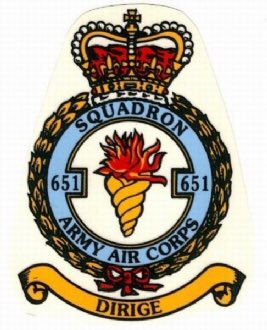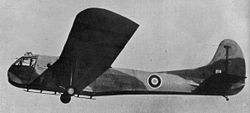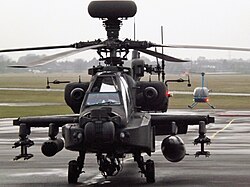
The Army Air Corps (AAC) is the aviation arm of the British Army, first formed in 1942 during the Second World War by grouping the various airborne units of the British Army. Today, there are eight regiments of the AAC, as well as two independent flights and two independent squadrons deployed in support of British Army operations around the world. Regiments and flights are located in the United Kingdom, Kenya, and Canada. Some AAC squadrons provide the air assault elements of 16 Air Assault Brigade, through Joint Helicopter Command.

Joint Helicopter Command Flying Station Aldergrove, also known as simply JHC FS Aldergrove, is a British military base located 4.4 miles (7.1 km) south of Antrim, Northern Ireland and 18 miles (29 km) northwest of Belfast, and adjoins Belfast International Airport. It is sometimes referred to simply as Aldergrove which is the name of a nearby hamlet.

667 Squadron AAC is a former squadron of the British Army's Army Air Corps (AAC).
No. 666 Squadron AAC (V) is a former squadron of the British Army's Army Air Corps (AAC). It was previously No. 666 Squadron RAF, a unit of the Royal Air Force during the Second World War and afterwards became a Royal Auxiliary Air Force (RAuxAF) squadron between 1 May 1949 and 10 March 1957.
No. 663 Squadron was an air observation post (AOP) unit, manned with Polish Army personnel, which was officially formed in Italy on 14 August 1944. Numbers 651 to 663 Squadrons were air observation post units working closely with Army units in artillery spotting and liaison. A further three of these squadrons, 664–666, were manned with Canadian personnel. Their duties and squadron numbers were transferred to the Army with the formation of the Army Air Corps on 1 September 1957.
663 Squadron AAC is a flying unit of the British Army's Army Air Corps (AAC).

No. 651 Squadron Army Air Corps, is an aircraft squadron of the British Army, originally formed as No. 651 Squadron Royal Air Force in Italy and North Africa during the Second World War, and afterwards in Egypt. Numbers 651 to 663 Squadrons of the RAF were air observation post units which had both Army and RAF personnel. The pilots, drivers and signallers were in the Royal Artillery whilst the adjutants, technical staff and equipment officers came from the RAF. Air observation posts were used primarily for artillery spotting, but occasionally for liaison and other duties. Their duties and squadron numbers were transferred to the Army with the formation of the Army Air Corps on 1 September 1957.
No. 671 Squadron AAC is squadron of the British Army's Army Air Corps. It was previously No. 671 Squadron RAF, a glider squadron of the Royal Air Force active during the Second World War as part of No. 229 Group RAF, South East Asia Command.
No. 659 Squadron was a Royal Air Force air observation post squadron associated with the 21st Army Group during World War II. Numbers 651 to 663 Squadrons of the RAF were air observation post units working closely with Army units in artillery spotting and liaison. Their duties and squadron numbers were transferred to the Army with the formation of the Army Air Corps on 1 September 1957.

No. 662 Squadron AAC is a squadron of the British Army's Army Air Corps (AAC) which flies the Boeing AH-64E Apache from Wattisham Flying Station as part of 3 Regiment Army Air Corps. It was formerly No. 662 Squadron, a Royal Air Force air observation post squadron associated with the 21st Army Group during the Second World War and later part of the Royal Auxiliary Air Force. Numbers 651 to 663 Squadrons of the RAF were air observation post units working closely with British Army units in artillery spotting and liaison. A further three of these squadrons, 664–666, were manned with Canadian personnel. Their duties and squadron numbers were transferred to the Army with the formation of the Army Air Corps on 1 September 1957.

658 Squadron AAC is an Army Air Corps unit of the British Army that provides dedicated aviation support to the 22nd Special Air Service Regiment for domestic counter terrorism (CT) operations. The squadron is co-located with 22 SAS at Stirling Lines. The press has given the squadron, their helicopters, and the CT response force they enable, the nickname "Blue Thunder". The squadron is part of the Joint Special Forces Aviation Wing.

No. 657 Squadron AAC was a squadron of the British Army's Army Air Corps (AAC), part of the Joint Special Forces Aviation Wing based at RAF Odiham. The squadron disbanded in May 2018 after the retirement of the Westland Lynx.
No. 660 Squadron AAC is a squadron of the British Army's Army Air Corps (AAC). It was formerly No. 660 Squadron RAF, a Royal Air Force air observation post squadron associated with the 21st Army Group during the Second World War. Numbers 651 to 663 Squadrons of the RAF were air observation post units working closely with British Army units in artillery spotting and liaison. A further three of these squadrons, 664–666, were manned with Canadian personnel. Their duties and squadron numbers were transferred to the Army with the formation of the Army Air Corps on 1 September 1957.
No. 654 Squadron AAC is a squadron of the British Army's Army Air Corps (AAC) that is currently the Headquarters Squadron for 4 Regt AAC. It was formerly No. 654 Squadron RAF, a unit of the Royal Air Force during the Second World War. Numbers 651 to 663 Squadrons of the RAF were air observation post units working closely with British Army units in artillery spotting and liaison. Their duties and squadron numbers were transferred to the Army with the formation of the Army Air Corps on 1 September 1957.
No. 652 Squadron AAC is a squadron of the British Army's Army Air Corps (AAC). It was previously No. 652 Squadron RAF, a unit of the Royal Air Force during the Second World War and afterwards in Germany.
664 Squadron AAC is a squadron of the British Army's Army Air Corps. It was formerly No. 664 Squadron, a Royal Air Force air observation post squadron associated with the Canadian 1st Army during the Second World War and later part of the Royal Auxiliary Air Force. Numbers 651 to 663 Squadrons of the RAF were air observation post units working closely with British Army units in artillery spotting and liaison. A further three of these squadrons, 664–666, were manned with Canadian personnel. Their duties and squadron numbers were transferred to the Army with the formation of the Army Air Corps on 1 September 1957.
No. 669 (HQ) Squadron AAC is a squadron of the British Army's Army Air Corps (AAC) which was disbanded as a flying Squadron on 31 July 2016 and reformed as HQ Sqn 3AAC in 2021. It was formerly No. 669 Squadron RAF, a glider squadron of the Royal Air Force active during the Second World War as part of No. 229 Group RAF, South East Asia Command
No. 672 Squadron AAC is a former squadron of the British Army's Army Air Corps (AAC). It was formerly No. 672 Squadron RAF, a Royal Air Force squadron that was operational during the Second World War within British India.
No. 668 Squadron AAC is squadron of the British Army's Army Air Corps. It was previously a glider squadron of the Royal Air Force active during the Second World War as part of No. 229 Group RAF, South East Asia Command.
No. 670 Squadron AAC is a squadron of the British Army's Army Air Corps. It is responsible for the Operational Conversion Phase of the Army Pilots’ Course. The Squadron is based at RAF Shawbury.










